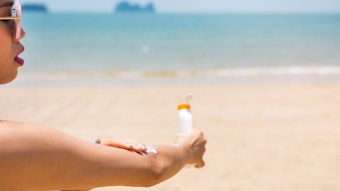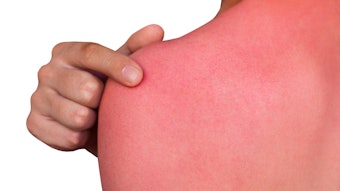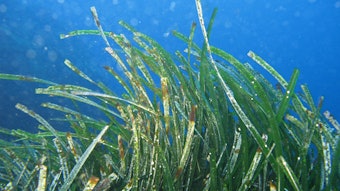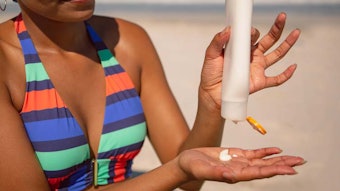In January 2011, the National Institute for Health and Clinical Excellence (NICE) in the United Kingdom issued public health guidance on skin cancer prevention and recommended that sunscreens possessing a Sun Protection Factor (SPF) of at least 15 were sufficient if applied adequately.1 More recently, in June 2011, the US Food and Drug Administration (FDA) published its long-awaited monograph2 in which the agency gave similar advice: …We continue to direct consumers to follow a comprehensive sun protection program that includes use of sunscreens with broad-spectrum SPF values of 15 or higher.
This advice is intended to focus on the minimum level of protection considered necessary to claim that sunscreens, when combined with limiting time in the sun and wearing clothes to protect sun-exposed areas, reduce the risk of skin cancer and early skin aging.2 However, a major reason that people use sunscreens, especially during recreational exposure, is to avoid sunburn. So is an SPF 15 sunscreen sufficient to achieve this goal?
It is certainly true that a photo-protective device, whether a sunscreen, shirt or shade, need only possess a protection factor of 15 to prevent sunburn in consumers behaving typically during all-day exposure to tropical summer sunshine.3 So in that sense, a sunscreen with an SPF 15 would be sufficient if it were delivering fifteenfold protection, which it would if it were applied at 2 mg/cm2—the thickness chosen by manufacturers to facilitate the testing process. But this amount is not based on user studies of how sunscreen is applied in real life.
It is well-known that people generally apply much less than this amount, and so will actually be getting less protection—typically, protection equivalent to about one-third of the labeled SPF.4 This mismatch between expected and delivered photoprotection has led many commentators into the trap of believing that consumers use inadequate amounts of sunscreen for protection, when the reality is the reverse: People use the quantity they feel comfortable with and in this sense are using the “correct” amount. It is the labeled SPFs that are misleading.
To say that SPF 15 is sufficient “if applied adequately” is impractical because it generally will not happen. Anyone who has ever actually tried applying sunscreen at 2 mg/cm2 over a large part of the body finds it virtually impossible as the sunscreen runs off of the skin, making it difficult to achieve a cosmetically pleasing application. This does not even factor in the cost of applying sunscreen adequately, since whole-body coverage for a single application at 2 mg/cm2 in an adult requires around 30 mL—meaning consumers will use a standard 200 mL bottle every two to three days if reapplied at least every 2 hr, as both the FDA and NICE recommend.
So in this author’s view, the advice that sunscreen should possess a labeled SPF of 15 or higher is not in the interest of public health, especially since it is often overlooked that the labeled SPF means roughly 50% of subjects in the laboratory assay achieved this level of protection or higher but equally, about 50% achieved lower levels of protection—and this is when the product is applied at 2 mg/cm2.
The minimum labeled sunscreen SPF recommended to avoid sunburn should instead be 30, since these products will deliver a protection factor of around 10 to most people who use the product. This should be sufficient to prevent sunburn under almost all circumstances. The same cannot be said if the recommendation is SPF 15, where generally only around fivefold protection will result, and where in instances of prolonged sun exposure, sunburn will and does result—the so-called sunscreen-sunburn paradox.5–9
Finally, remember that sunscreens are commonly used during vacations, where sun exposure occurs daily for as many as a two weeks. The time course of erythema is such that a sub-erythemal response could be the result at the end of a single day’s sun exposure on sunscreen-protected skin, but a definite erythema might be seen a few days into the vacation if the same daily sub-erythemal exposure is delivered over several days.10
Consequently, it would be wise to err on the high side of SPFs if sunburn is to be avoided in almost every eventuality, so that public health agencies are not faced with disgruntled consumers who followed their advice but still ended up with sunburned skin.
Engage in this debate on the Cosmetics & Toiletries magazine LinkedIn Group (join us, if you are not yet a member), or to submit your own topic or column to [email protected].
References
- National Institute for Health and Clinical Excellence, Skin cancer: Prevention using public information, sun protection resources and changes to the environment, available at www.nice.org.uk/nicemedia/live/13310/52562/52562.pdf (accessed Dec 4, 2011)
- Department of Health and Human Services, FDA, USA, Labeling and effectiveness testing; Sunscreen drug products for over-the-counter human use, Federal Register 76(117) 35620-35665, 17 (Jun 2011)
- BL Diffey, Has the sun protection factor had its day? Br Med J 320 176-177 (2000)
- BL Diffey, Sunscreens: Expectation and realization, Photodermatol Photoimmunol Photomed 25 233–236 (2009)
- P Autier, M Boniol and J-F Doré, Sunscreen use and increased duration of intentional sun exposure: Still a burning issue, Int J Cancer 121 1–5 (2007)
- MA Wright, ST Wright and RF Wagner, Mechanisms of sunscreen failure, J Am Acad Dermatol 44: 781–784 (2001)
- BL Diffey and Z Norridge, Reported sun exposure, attitudes to sun protection and perceptions of skin cancer risk: A survey of visitors to Cancer Research UK’s SunSmart campaign website, Br J Dermatol 160 1292–1298 (2009)
- H Dixon, R Shatten and R Borland, Reaction to the 1995/1996 SunSmart Campaign: Results from a representative household survey of Victorians, in: SunSmart Evaluation Studies No 5. Melbourne: Anti-Cancer Council of Victoria 70–96 (1997)
- T-C Ling, C Faulkner and LE Rhodes, A questionnaire survey of attitudes to and usage of sunscreens in northwest England, Photodermatol Photoimmunol Photomed 19 98–101 (2003)
- AR Young, GE Orchard, GI Harrison and JL Klock, The detrimental effects of daily sub-erythemal exposure on human skin in vivo can be prevented by a daily-care broad-spectrum sunscreen, J Invest Dermatol 127 975–978 (2007)










